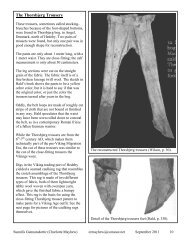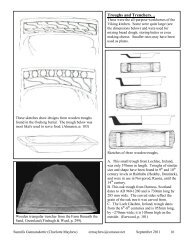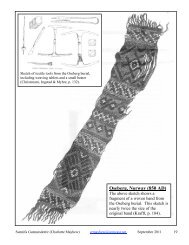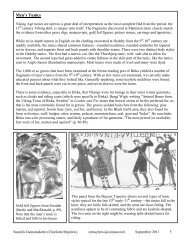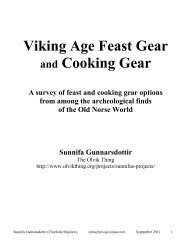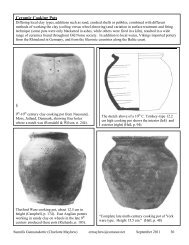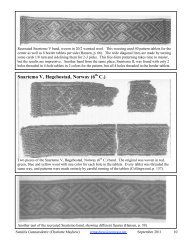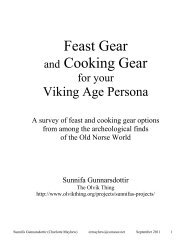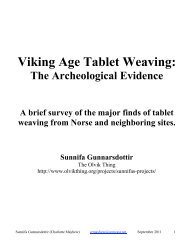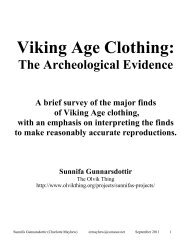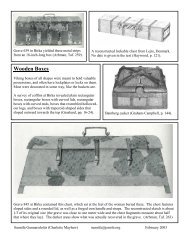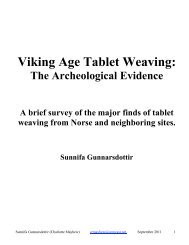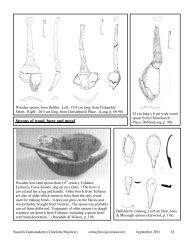Hanging Bowls - Olvik Thing
Hanging Bowls - Olvik Thing
Hanging Bowls - Olvik Thing
You also want an ePaper? Increase the reach of your titles
YUMPU automatically turns print PDFs into web optimized ePapers that Google loves.
Metal hanging bowl from a rich female grave in Skei,<br />
Nord Trondelag, Norway (Viking Heritage, p. 32).<br />
<strong>Hanging</strong> <strong>Bowls</strong><br />
28 hanging bowls have been found in Viking contexts,<br />
with others found in Anglo-Saxon and Irish sites.<br />
Earlier hanging bowls are fairly plain. Over time, the<br />
bowls were ornamented with escutcheons on the<br />
inside center, bottom center, and below the hanging<br />
rings. The most elaborate hanging bowl is from the<br />
Sutton Hoo burial; the bowl featured a stag statue<br />
standing on an enameled escutcheon in the middle of<br />
the bowl. The purpose of hanging bowls is still not<br />
known. though it has been suggested that they were<br />
used as oil lamps, as storage vessels, or for food.<br />
This unusually-shaped 6 th -7 th century wooden<br />
hanging bowl was found in Cuillard, Ireland.<br />
Note the bowl’s similarity to the Skei, Norway<br />
bowl. The ruler shows 10 cm. (Earwood, p. 104)<br />
This 7 th century copper alloy hanging bowl with<br />
enameled escutcheons came from Winchester,<br />
Hampshire, England (Youngs, p. 48).<br />
Irish copper-alloy hanging bowl inlaid with enamel<br />
found in an 8 th -9 th C man’s grave in Myklebustad,<br />
Norway (Philpott, pages 12 & 73).<br />
<strong>Hanging</strong> bowl from Sutton Hoo burial Mound 1,<br />
with inlaid enamel escutcheons. Diameter 310<br />
mm, restored (Carver, p. 134).<br />
Sunnifa Gunnarsdottir (Charlotte Mayhew) crmayhew@comcast.net September 2011 27
Soapstone <strong>Bowls</strong><br />
Soapstone bowls were used for food preparation, serving,<br />
and/or eating, depending on their size.<br />
9 th C 33.5cm diameter soapstone bowl from<br />
Fitje, Gloppen (Roesdahl & Wilson, p. 244).<br />
This 57.5 cm soapstone bowl from Kollsøyo, Fjellberg,<br />
Hordaland, Norway, is the largest example of a common<br />
Viking type. Soapstone bowls were often exported from<br />
Norway and SW Sweden (Roesdahl & Wilson, p. 250).<br />
Soapstone bowl (Simpson, p. 60).<br />
“This hemispherical bowl recovered in the excavations at Stöng is made of local volcanic tuff, a more readily<br />
available material than the soapstone that was characteristically used to make bowls of this type in the<br />
Scandinavian homelands.” The bowl is Viking or just post-Viking. (Graham-Campbell, VW, p. 172)<br />
Sunnifa Gunnarsdottir (Charlotte Mayhew) crmayhew@comcast.net September 2011 28
These two soapstone pots were found in the Jarlshof, Shetland, excavations (Haywood, p. 180).<br />
A selection of steatite and soapstone lamps<br />
from Scotland; note the different shapes.<br />
“Small round bowls occur in all periods, while<br />
oval ones were used mostly in the 10 th and 11 th<br />
century. The square ones became popular in<br />
the 11 th century.” (Owen, p. 33)<br />
These square steatite bowls were also found at Jarlshof, Shetland. The vessels found there range in shape<br />
from round, to oval, to square or rectangular, depending on the time they were made (Ritchie, p. 62).<br />
Sunnifa Gunnarsdottir (Charlotte Mayhew) crmayhew@comcast.net September 2011 29



